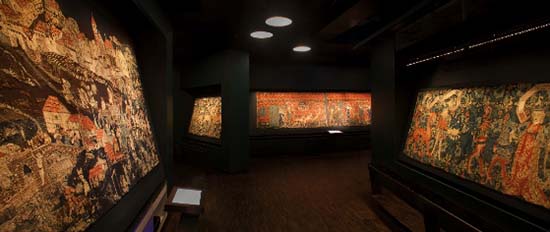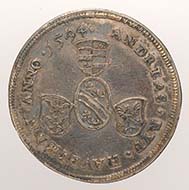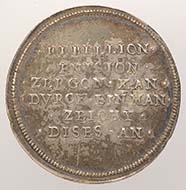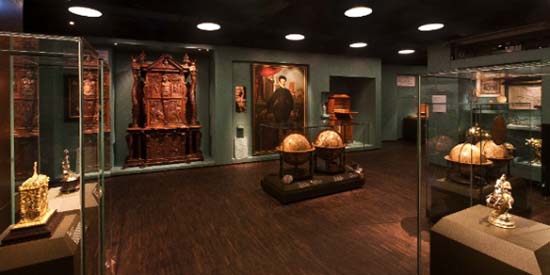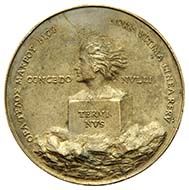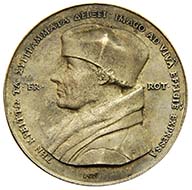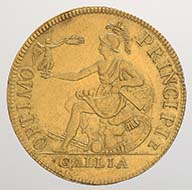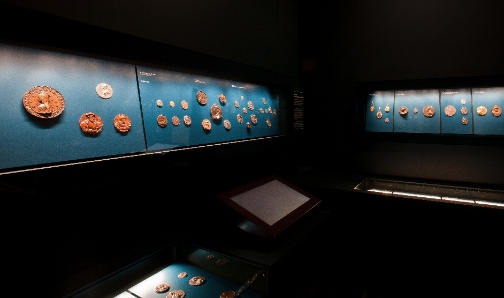November 17, 2011 – Basel Historical Museum’s new permanent exhibition in the basement of the Barfüßer Church has opened on 13th November, concluding the most important milestone in the modernization of the museum. With 1200 square metres of state-of-the-art exhibition space at its disposal, the museum has been able to redesign its permanent exhibition from the ground up. The new show appropriately titled “Understanding the World” reveals how perceptions of the world change over time and invites visitors to take a fresh look at its superb collection.
The tapestries in the exhibition. Photo: HMB Philipp Emmel.
Works of art, scientific artefacts and objects of everyday use tell us a lot about how people perceive the world. While the Basel tapestries from the Late Middle Ages depict alternative fantasy worlds, the cabinets of curiosities in which 16th-, 17th- and 18th-century collectors amassed objects from all fields of study paint a vivid picture of what was already known about the real one. While coins and medals have been telling us about peoples and cultures for more than two and a half millennia, the archaeological excavations conducted since the Renaissance have greatly added to our knowledge of ancient civilizations and lost worlds.
Basel. Medal: The peaceful end of the so-called Rappenkrieg, 1594. Silver, engraved. From the Remigius Faesch Collection. 10.685 g. Inv. 1905.1400.
The exhibition thus gives visitors an insight into how people in the past imagined the world as they tried to make sense of it. The theme “Understanding the World” is the common thread linking focal areas of the collection through the centuries. After a ten-year absence, the history of Basel itself, which archaeologists have traced back to the Celts, is once again an integral part of the permanent exhibition. The late medieval tapestries can also be appreciated as never before. And at the centre of the exhibition is Basel Historical Museum’s collection of Kunstkammer, underscoring Basel’s role in the history of private collecting in the Early Modern Age. After all, it was these private cabinets of curiosities that laid the groundwork for Basel’s emergence as a major museum city.
Visitors to the exhibition will find plenty to marvel at; and because their information needs are sure to vary, there is a wide range of additional information sources, entertainment and interactive experiences to choose from. In addition to the audio and multimedia stations where visitors can learn more about specific objects, there is a special level for children which turns the spotlight on the exhibits most likely to be of interest to them. Another new feature is the room specially equipped for talks and presentations and practical work with groups.
Tour of the Museum
The 2,500 exhibits are grouped into 52 “chapters” and three main sections, each of which represents a different approach to “Understanding the World”:
– Scenes of Real Life and Fantasy Worlds – Medieval Tapestries
– A World in Small – The Great Cabinet of Curiosities; and adjoining it the Burgundian Booty and the Coin Cabinet
– Hidden Worlds – Archaeology in Basel
Cabinet of curiosities from outside. Photo: HMB Philipp Emmel.
The tour starts with a globe cup dated 1550 from the Amerbach Cabinet and an armillary sphere (tabletop planetarium) dated 1770. Being representative, respectively, of the geocentric and heliocentric worldview, they exemplify how perceptions of man’s place in the universe changed during the 200 years separating them.
Scenes of Real Life and Fantasy Worlds – Medieval Tapestries: Visitors enter the world of the Middle Ages through a Late Gothic parlour. Suddenly they are in a garden populated by courting noblemen and ladies, by “wild men” out hunting and by animals both real and mythical, including dragons, griffins and unicorns. Some of the tapestries are up to six metres long and the stories they tell range from colourful scenes of everyday life to pure fantasy worlds. They attest both to the courtly ideals of the age and to the power of the late medieval imagination.
The fourteen Late Gothic tapestries are among the most highly prized treasures in the collection. While some are embroidered, most are traditional tapestries, woven by the highly skilled tapestry-weavers of Basel and Strasbourg on the Upper Rhine, who in the course of the 15th century brought this textile art to new heights. Thanks to modern lighting technology and the decision to dispense with glass showcases, the beautiful colours and tactile quality of these enchanting tapestries can now be appreciated as never before.
A World in Small – The Great Cabinet of Curiosities: Several major collectors in Basel between the 16th and 18th century created “a world in small” for their own private enjoyment.
Medal: Erasmus von Rotterdam, Quentin Massys (Leuven c. 1456-1530 Antwerp), dated to 1519, cast probably c. 1524. From the property of Erasmus of Rotterdam. 333.68 g. Inv. 1916.288.
The theme of collecting is introduced by the estate of Erasmus of Rotterdam, which following his death in Basel in 1536 became the rootstock of the Amerbach Cabinet.
France, Kingdom. Henry II (1547-1559), Double Henri d’or “à la Gallia”, Mint Paris Moulin des Étuves, no date (c. 1554/55). From the property of Basilius Amerbach. Gold, 27.9 mm, 7.312 g. Inv. 1918.2207.
Erasmus, however, is but the first in a long line of collectors presented here in chronological order: the legal scholar Basilius Amerbach, the merchant Andreas Ryff, the doctor and natural philosopher Felix Platter, the lawyer Remigius Faesch, the coin collectors of the Schorndorff family and the local historians and art lovers Daniel Bruckner and Daniel Burckhardt-Wildt. The line ends with the cultural historian Jacob Burckhardt and the German scholar Wilhelm Wackernagel, both of whom were instrumental in putting collecting on a scientific footing. That was in the 19th century, the dawn of the museum age when the collections held in Basel, like those elsewhere, were dispersed among separate museums. In addition to portraits, this gallery fittingly features some remarkable collecting cabinets as well.
Cabinet of curiosities inside. Photo: HMB Philipp Emmel.
This section of the exhibition brings together a vast array of objects from the world of nature, history, art and science in one Great Cabinet of Curiosities. This Wunderkammer takes the form of a free-standing pavilion set apart from its surroundings. Here, visitors can marvel at wondrous inventions of nature such as the “Devil’s Finger” and a bird of paradise, as well as man-made curiosities such as some artfully handcrafted coconut goblets, various archaeological finds and scientific instruments. The four collection categories Naturalia, Antiquitates, Artificialia and Scientifica are modelled on the ordering system of the “ideal” cabinet of curiosities. The metal outer cladding of the cabinet is inscribed with quotes from the inventories of various private collectors – a feature which lends it a monumental character. Grouped around the Great Cabinet of Curiosities are several spectacular items from the Amerbach Cabinet and the Faesch Museum which here are arranged according to theme. Items on permanent loan from the University Library, the Kunstmuseum Basel, Basel Natural History Museum and Basel Pharmacy Museum round off the collection in this section.
Coin cabinet. Photo: HMB Philipp Emmel.
The Great Cabinet of Curiosities is also the fulcrum leading to two adjoining sections: the Burgundian Booty and a collection of coins and medals, which as legal tender and miniature works of art cover a longer time span and a larger geographical compass than any other group of objects in the museum. The coins presented here under the heading “The World’s History in Your Hand” tell us a lot about times past, while the focus in the case of medals is on their function as works of art and propaganda immortalized in metal.
Hidden Worlds – Archaeology in Basel: Starting in the 16th century, Basel’s private collectors conducted their own archaeological excavations and added their own and each other’s finds to their own collections. This is the link leading to the third section of the exhibition, which in turn traces an arc to modern archaeology. The exhibits on show here tell the story of Basel’s origins as a city from the first Celtic settlements on the bend in the Rhine to its ascendancy as an Episcopal see. The Celts built two major settlements here even before the Romans made what would later become Basel part of their world empire. When the Roman troops withdrew, their place was taken by the Alemanni, who brought their own culture with them. The relocation of the Episcopal see from Augst to Basel during the period of Frankish rule paved the way for further growth on the Münsterhügel or Cathedral Hill. The model settlements and painstaking reconstructions based on real discoveries presented in this section provide a fascinating insight into how Basel came to be the city it is today. Interactive exhibits where visitors can dig, sample, solve puzzles, and listen make this part of the exhibition especially attractive for children.
Design
The exhibition architecture designed by Ursula Gillmann of the Basel-based firm of that name obscures the tripartite layout dictated by the pillars supporting the three-nave basilica above. The asymmetrical display cases and presentation elements generate a town-like layout of twists and turns with a main street, squares, courtyards and even interiors. These are the period rooms that have been in the museum since 1894 and have now been incorporated into the permanent exhibition underneath the south side-aisle. The three sections are colour-coded. The vaulted crypt of the choir is pale in colour and does not contain any ceiling-high installations; many of the archaeological finds are exhibited in floor-level glass cases instead. In addition to detailed wall texts, there are twenty-one media stations where visitors can watch films, listen to audio texts and find out more about the exhibits. The texts introducing each “chapter” are provided in three languages.
The basement was modernized under the supervision of the architect Gian Fistarol in consultation with the Building and Planning Department. The technical infrastructure was comprehensively overhauled for the first time in thirty years and two new rooms were added: one for museum attendants and one for talks and events.
The larger project
The opening of the new permanent exhibition in the basement of the Barfüßer Church was the last major milestone in the modernization of the museum that began in 1996. This is the fourth time the permanent exhibition has been reorganized since the Barfüsser Church became the museum’s new home in 1892. This latest project grew out of a change of concept. In 2008, the history of the city that had occupied the basement since it was first opened in 1981 was literally “brought up from the cellar” and set up in the nave, the rood screen chapels and the two galleries, where it has been attracting visitors ever since.
Costs
This last stage in the museum’s modernization cost CHF 7 million to complete. The project as a whole which began fifteen years ago has cost CHF 18 million in total. The permanent exhibition accounted for half of this sum, while the other half was spent on structural and technical modifications and modernization work. The Canton Basel-Stadt bore the lion’s share of the costs (CHF 12.4 million), while thanks to the support of third parties, first and foremost among them the Foundation of Basel Historical Museum, the museum itself was able to raise about a third of the total or CHF 5.6 million.
New website
To mark the opening of the new permanent exhibition, the HMB has launched a new user-friendly, barrier-free website. In addition to important practical information as well as facts and figures about the museum, the website also gives users a glimpse behind the scenes and provides a timeline for browsing the collection and conducting more systematic research.
The tie-in book
The tie-in book is called „Die grosse Kunstkammer“ and is published by Christoph Merian Verlag.
To find out more about the exhibition, please visit the new website.




